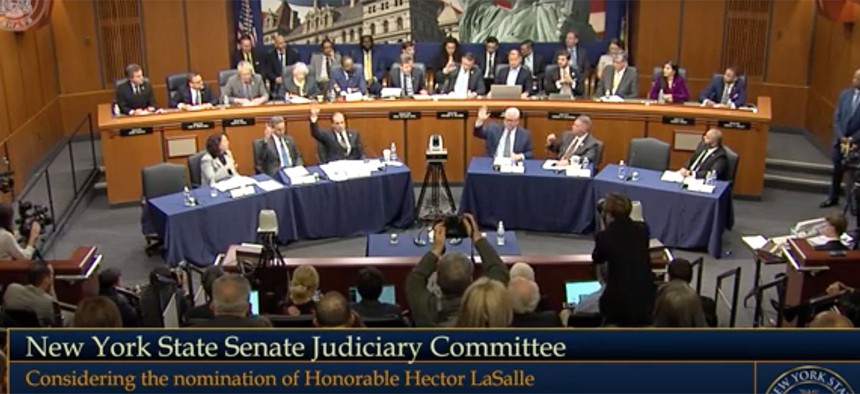Politics
7 senators voted ‘without recommendation’ on LaSalle. What does that mean?
Until Wednesday, that third option received little attention.

On Wednesday the committee members didn’t just have two options to vote – they had three. The tally came out as two in favor, seven without recommendation and 10 opposed. Screenshot, New York state Senate
When all was said and done following an hours-long state Senate Judiciary Committee hearing Wednesday, the majority of the members decided not to advance Justice Hector LaSalle to the floor for a full chamber vote. But committee members didn’t just have two options to vote – they had three. Ultimately, the tally came out as two in favor, seven without recommendation and 10 opposed. Although in effect, the vote meant 10 rejected LaSalle’s advancement while nine supported it, the nuance between the three options historically hasn’t mattered nearly as much as it did after Wednesday’s hearing.
Normally, when the Judiciary – or any – Committee votes on a nominee from the governor, members have two responsibilities: They must vote on whether that person will advance to floor, and whether they recommend that person to actually get confirmed by their colleagues. Voting in favor of the nominee means the committee member both recommends the nominee to the full Senate and that they support advancing that person to the floor. In all but one instance in New York, Court of Appeals nominees have advanced out of the Judiciary Committee with its recommendation.
Historically, the option of voting “aye without recommendation” has held very little importance for that reason. It’s a way of signaling that they may not support the nominee’s full confirmation, but at the very least support that person making it to the full Senate for a vote. Since only one Court of Appeals nominee has ever made it out of committee without recommendation, the distinction between voting yes and voting “without recommendation” has mattered little. Directly voting down a judicial nominee in committee means the member does not support that person advancing at all. Before LaSalle, the Judiciary Committee had never rejected a Court of Appeals nominee.
In 2013, Court of Appeals Judge Jenny Rivera became the first, and so far only, judicial nominee in New York to advance to the floor without the committee’s recommendation. At the time, Republicans controlled the state Senate and many initially did not support then-Gov Andrew Cuomo’s pick for the court. In the Judiciary Committee, where Republicans made the majority, only the 11 Democrats at the time voted in favor. But the Republicans ultimately split, with three deciding to vote “aye without recommendation.” The nine other Republicans voted to reject her, but that wasn’t enough to stop her from getting a full floor vote. So Rivera had the majority of votes to advance, but did not have the majority needed to receive the committee’s recommendation.
The distinction between the three voting options again came to attention in 2021 when Cuomo nominated then-Nassau County District Attorney Madeline Singas to the Court of Appeals, the bench she now sits on. Her prosecutorial record resulted in opposition from progressives, who called on state senators to reject her nomination. In the Judiciary Committee, only one Democrat voted against Singas: former state Sen. Alessandra Biaggi. State Sens. Jamaal Bailey and Brad Hoylman-Sigal, the committee’s chair, voted “without recommendation,” allowing her to at least advance. (In the full floor vote, Bailey voted yes and Hoylman-Sigal voted no.) And with the support of every other Democrat and all but one Republican, Singas received the committee’s recommendation as well.
NEXT STORY: NY Democrats reject Hector LaSalle

